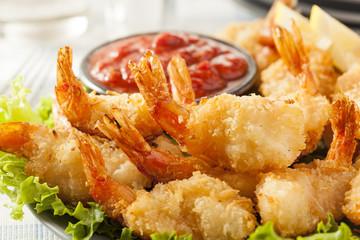New Years Recipes

Coconut Shrimp
New Years Recipes
If you’re planning a New Year’s Eve party, why not try out some new recipes? There are plenty of finger foods and other appetizers that you can prepare. One key to having a successful party- have plenty of food and drink on hand. As a general rule, and if you’re serving small appetizers, try to have three to four small finger foods per guest. Also, keep in mind that there is usually a second wave of eating that takes place later in the evening. Here is my recipe for Coconut Shrimp with Lime Aioli; it’s always a huge hit.
Have fun, and don’t forget to ring in the New Year with good friends, family, and great food!
Chef Chuck Kerber
Coconut Shrimp
- 1 dozen large shrimp (peeled and deveined)
- 4 beaten eggs
- 1 cup flour
- 1 cup flaked coconut
- 1 cup *Panko Bread Crumbs
- Salt and Pepper to taste
4 Tablespoons butter
Lime Aioli
- 1/2 cup mayonnaise
- ½ cup sour cream
- Zest of 2 limes
- Juice of 1 lime
- 2 Tablespoons honey
- Salt and pepper to taste
For the Shrimp:
Season the shrimp with salt and pepper. Place in order, shrimp, flour, beaten eggs, and combined coconut and Panko bread crumbs. Bread the shrimp by placing first in the flour, eggs, and bread crumb mixture. Repeat until all of the shrimp have been breaded. Melt butter in a hot non-stick skillet. Sauté shrimp until they’re golden brown on each side. Set cooked shrimp on a paper towel to absorb excess oil. Place on a cookie sheet with aluminum foil. Set aside.
For the Aioli:
Mix all of the Aioli ingredients in a metal mixing bowl and whisk. Set aside.
To Finish:
Place the shrimp in a 350 degree oven and bake for 5 minutes. Transfer shrimp to a serving platter and serve with the Lime Aioli.
*Panko Bread crumbs defn: is a variety of bread crumb used in Japanese cuisine as a crunchy coating for fried foods such as tonkatsu. Panko is made from bread without crusts, thus it has a crisper, airier texture than most types of breading found in Western cuisine[citation needed]. Outside Japan, it is becoming more popular for use in Asian and non-Asian dishes, and is often available in Asian markets and specialty stores. Increasingly, it is also available in many large supermarkets. Panko is produced worldwide, particularly in Asian countries including Japan, Korea, Thailand, China and Vietnam.
*When whisking always use a metal bowl, never use glass!!!
Enjoy!
Chef Chuck Kerber






 in <b>/var/www/vhosts/cooksandeats.com/httpdocs/wp-content/themes/CooksandEats/sidebar.php</b> on line <b>1</b><br />
/wp-content/themes/CooksandEats/images/side-logo.png)



 in <b>/var/www/vhosts/cooksandeats.com/httpdocs/wp-content/themes/CooksandEats/footer.php</b> on line <b>13</b><br />
/wp-content/themes/CooksandEats/images/back-to-top.png)
I am impressed with all this useful information. Was WAY more than I expected.
Thanks!
Chef Chuck